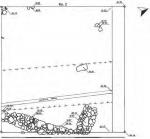Summary (English)
EXPLORATIONS NEAR THE VILLAGE OF KALIPETROVO (Georgi Atanasov – geoatal@abv.bg) An archaeological structure has been partly destroyed during the leveling of the terrain with machines. During the rescue explorations, an area was documented, c. 20 m long, where a partly destroyed wall was visible and a large quantity of fragmentary roof-tiles and sherds were collected. A layer with fragmentary tiles from the collapsed roof was explored, up to 30 cm thick. The finds comprised sherds of the 3rd – 4th centuries AD, including sherds from red-gloss pottery and from amphorae, two coins (one of them dated to the 4th century AD), two appliqués and iron objects. The partly destroyed wall was explored. It was 40 cm wide, built in rubble masonry and was an interior wall inside the building. Trenches from destroyed walls were explored, containing fragments from mortar and plaster. Pit No. 1 was excavated, containing fragmentary roof-tiles. The excavated remains belonged to a large building, most probably villa suburbana or villa rustica, which was abandoned before the end of the 4th century AD. Judging from the fragmentary wall plaster, the interior of some rooms was painted in Pompeian red. A corner of another building was explored at c. 500 m from the first one. The walls were 60 cm wide, built in rubble masonry. The finds comprised fragmentary roof-tiles, sherds of the 3rd – 4th centuries AD, two coins (Roman and Ottoman), a round appliqué showing dolphins, a terracotta spindle whorl and iron objects. A grave was explored at c. 50 m from the building, 1.68 m long and built of bricks, c. 40.5 cm by 27 cm by 5 cm in size. The grave was empty without human remains and finds. The building was most probably villa suburbana or villa rustica, which was abandoned before the end of the 4th century AD. Three water-conduits were discovered in the vicinity of the villas, constructed from terracotta pipes from 8.8 to 15 cm in diameter.
- Georgi Atanasov - Regional Museum of History – Silistra
Director
Team
Research Body
- Regional Museum of History – Silistra






![Download [PDF]](/excavation/skins/fasti/images/results/download_sml.png)



